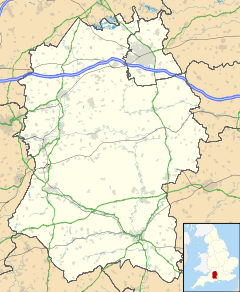- Nile Clumps
-
Coordinates: 51°10′50″N 1°47′58″W / 51.1805°N 1.799526°W
The Nile Clumps 
Four of the Nile Clumps (which are on private land) seen from an information board on a public bridleway
 The Nile Clumps shown within Wiltshire
The Nile Clumps shown within WiltshireList of places: UK • England • Wiltshire The Nile Clumps are a series of tree clumps near Amesbury on Salisbury Plain in Wiltshire, England, purportedly planted to commemorate the Battle of the Nile.
Contents
Background
Between the 1st and 3rd of August 1798 a British fleet, under Admiral Horatio Nelson, defeated a French fleet, under François-Paul Brueys d'Aigalliers, in Aboukir Bay, in the Battle of the Nile. The French fleet consisted of thirteen ships of the line and four frigates. Nelson had fourteen ships of the line. All but four of the French ships were destroyed or captured. No British ships were lost.
After Nelsons death at the Battle of Trafalgar, it is believed that Charles Douglas, 6th Marquess of Queensberry, a friend of Nelson's mistress, Emma Hamilton, planted clumps of beech trees on his estate near Amesbury to commemorate him. Each clump represented the location of a British or French ship at a particular point in the battle.
There may have been as many as twenty six clumps originally, spread out over three quarters of a mile, of which some seventeen remain.
The Nile Clumps today
Seventeen clumps remain today and are now under preservation orders.[1] However, as beech has a natural life of some 200 years many are dying off. Many clumps are being replanted by local volunteers,[2] each with about 200 mixed trees including beech, maple and hawthorn. Amongst the clumps that have been replanted are those for Swiftsure, Defence, L'Orient and Bellerophon.
The evidence that the clumps were planted to commemorate the battle is based on local lore and a similarity between the layout of the woods and the position of ships shown in Robert Dodd’s map of the battle. The UK National Maritime Museum has also suggested that the link between the Battle of the Nile and the clumps is “quite likely”.[3]
Most of the surviving clumps stand on the north side of the A303 to the west of Amesbury and inside the Stonehenge World Heritage Site, although several used to stand south and along the course of the road. Several of the remaining clumps stand on land owned by the National Trust's Stonehenge Landscape property.Other woods
On the 13th November 2003 the London Daily Mail reported that on the former Swarland Estate, near Alnwick [in North East England], once owned by Nelson's friend and agent Alexander Davison, a line of trees, viewed from above, takes on the shape of the coastline of the Nile delta. Other trees are in the positions of the British and French ships. Aerial photographs suggest that the trees may be at 55°19′10.72″N 1°44′20.25″W / 55.3196444°N 1.7389583°W. Davison also erected an obelisk at Swarland. A plaque at the obelisk mentions the woods and states that they are to the west of the monument.
The Nile Clumps are sometimes incorrectly referred to as the Trafalgar Clumps. There is a separate Trafalgar Woods project to plant a total of 250,000 trees in a series of woods across the UK to commemorate the 2005 bicentenary of the Battle of Trafalgar. There will be a total of 33 clumps, each representing a ship which took part in the battle. The largest will be Victory Wood in Kent with 100,000 trees.
See also
References
- ^ http://archive.wiltshiretimes.co.uk/2002/4/11/191274.html
- ^ http://archive.thisiswiltshire.co.uk/2005/10/12/251743.html
- ^ Roe, Nicholas (1998-06-20). "Battle of the Nile: Round Two". The Daily Telegraph: pp. 11.
Categories:- Monuments and memorials in England
- Horatio Nelson
- Geography of Wiltshire
Wikimedia Foundation. 2010.



